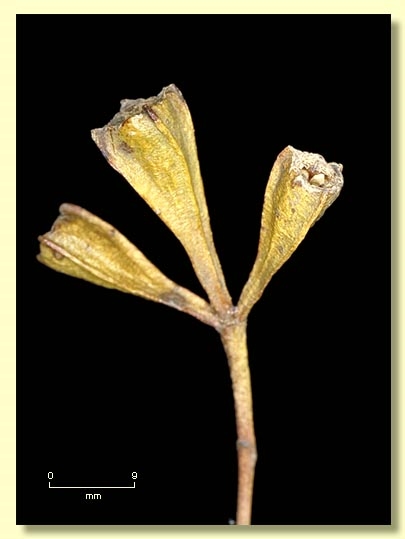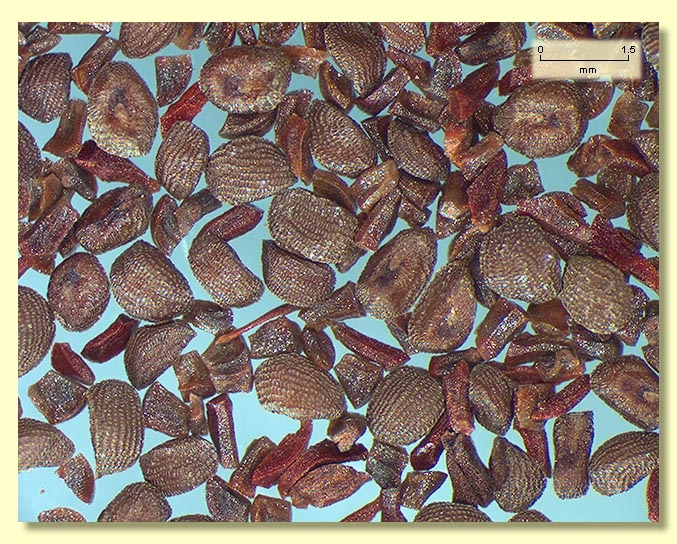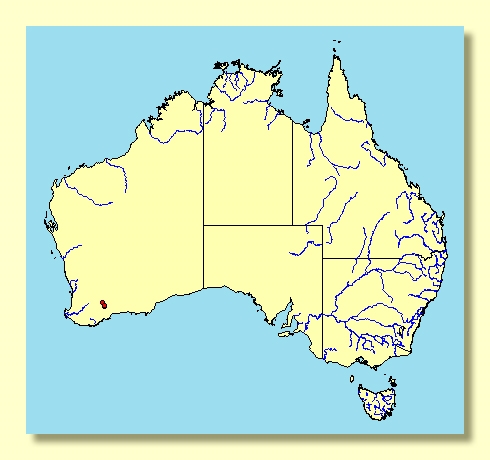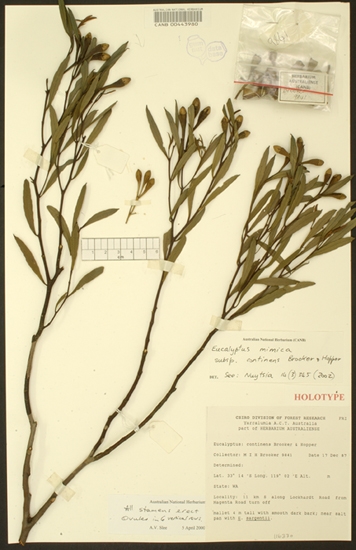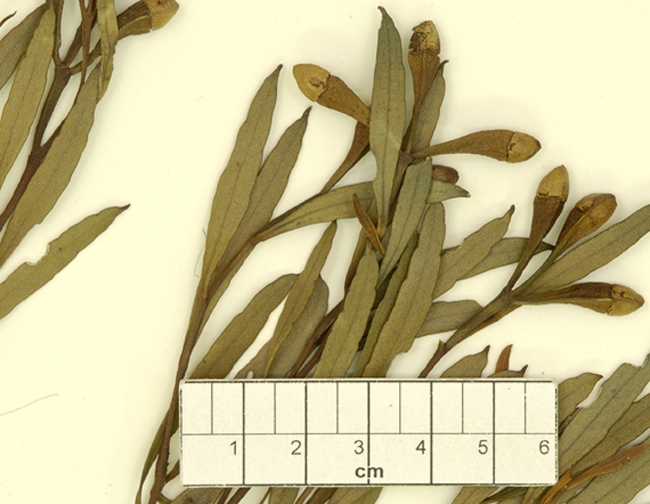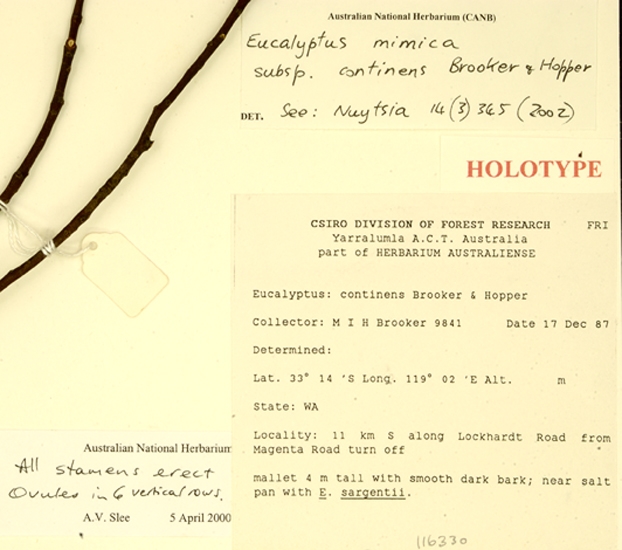Eucalyptus | Symphyomyrtus | Bisectae | Glandulosae | Erectae | Abundae
Euclid - Online edition
Eucalyptus mimica subsp. continens
Classification
Nomenclature
Description
Mallet to 5 m tall. Lignotuber absent.
Bark smooth throughout, dark and light grey to greenish grey over coppery or brown.
Branchlets have oil glands in the pith.
Juvenile growth (coppice or field seedlings to 50 cm): not seen.
Adult leaves held erect, alternate, petioles 0–0.5 cm long; blade narrowly elliptical to linear, 3.5–7.7 cm long, 0.4–0.8 cm wide, base tapering to petiole, margin entire or distantly indented, apex pointed, concolorous, green, glossy, the surface appearing "glazed", midrib usually visible, side-veins and reticulation invisible, obscured by numerous oil glands.
Inflorescence axillary unbranched, peduncles 0.7–1.5 cm long, buds 3, pedicellate (pedicels 0.5–1 cm long). Mature buds broadly fusiform in outline (1.2–1.8 cm long, 0.5–0.6 cm wide), the hypanthium strongly 3 or 4-angled, operculum conical to pyramidal, the outer operculum persisting until bud maturity but becoming scarious and easily separable from inner operculum (occasionally the outer operculum may shed before flowering to reveal a warty inner operculum), stamens erect, anthers oblong, versatile, dorsifixed, dehiscing by longitudinal slits, style long and straight, stigma blunt to slightly dilated, locules 3 or 4, the placentae each with 6 vertical rows of ovules. Flowers not seen.
Fruit pedicellate (pedicels 0.5–0.7 cm long), obconical in outline and triangular to square in cross-section having 3 or 4 prominent angles and slightly curved faces between, 0.8–1.7 cm long, 0.6–1.2 cm wide, disc descending, hidden by the persistent narrow staminophore, valves 3 or 4, near rim level.
Seeds dark brown, 0.7–1.5 mm long, ovoid to flattened-ovoid, dorsal surface clearly and shallowly reticulate, hilum ventral.
Cultivated seedlings (measured at node 10): cotyledons Y-shaped (bisected); stems rounded in cross-section, smooth or slightly warty; leaves subsessile to shortly petiolate, opposite for 3–6 nodes then alternate, linear, 4.5–6.5 cm long, 0.5–1.2 cm wide, dull, green for ca 10 nodes then glossy. Lamina, midrib and margin with sparse warts and may feel slightly roughened when fresh.
Bark smooth throughout, dark and light grey to greenish grey over coppery or brown.
Branchlets have oil glands in the pith.
Juvenile growth (coppice or field seedlings to 50 cm): not seen.
Adult leaves held erect, alternate, petioles 0–0.5 cm long; blade narrowly elliptical to linear, 3.5–7.7 cm long, 0.4–0.8 cm wide, base tapering to petiole, margin entire or distantly indented, apex pointed, concolorous, green, glossy, the surface appearing "glazed", midrib usually visible, side-veins and reticulation invisible, obscured by numerous oil glands.
Inflorescence axillary unbranched, peduncles 0.7–1.5 cm long, buds 3, pedicellate (pedicels 0.5–1 cm long). Mature buds broadly fusiform in outline (1.2–1.8 cm long, 0.5–0.6 cm wide), the hypanthium strongly 3 or 4-angled, operculum conical to pyramidal, the outer operculum persisting until bud maturity but becoming scarious and easily separable from inner operculum (occasionally the outer operculum may shed before flowering to reveal a warty inner operculum), stamens erect, anthers oblong, versatile, dorsifixed, dehiscing by longitudinal slits, style long and straight, stigma blunt to slightly dilated, locules 3 or 4, the placentae each with 6 vertical rows of ovules. Flowers not seen.
Fruit pedicellate (pedicels 0.5–0.7 cm long), obconical in outline and triangular to square in cross-section having 3 or 4 prominent angles and slightly curved faces between, 0.8–1.7 cm long, 0.6–1.2 cm wide, disc descending, hidden by the persistent narrow staminophore, valves 3 or 4, near rim level.
Seeds dark brown, 0.7–1.5 mm long, ovoid to flattened-ovoid, dorsal surface clearly and shallowly reticulate, hilum ventral.
Cultivated seedlings (measured at node 10): cotyledons Y-shaped (bisected); stems rounded in cross-section, smooth or slightly warty; leaves subsessile to shortly petiolate, opposite for 3–6 nodes then alternate, linear, 4.5–6.5 cm long, 0.5–1.2 cm wide, dull, green for ca 10 nodes then glossy. Lamina, midrib and margin with sparse warts and may feel slightly roughened when fresh.
Flowering Time
Flowering time unknown.
Notes
Eucalyptus mimica is a mallet species endemic to Western Australia, found only in the area immediately south of Newdegate in the southern wheatbelt. It is smooth-barked with a crown of linear to narrowly elliptical, green, glossy leaves with little visible venation and numerous oil glands.
Eucalyptus mimica is a somewhat atypical species in Eucalyptus subgenus Symphyomyrtus section Bisectae subsection Glandulosae because the outer operculum of the buds does not shed early leaving an operculum scar (see description above); however, the cotyledons are bisected, branchlets have oil glands in the pith and adult leaves have a glazed surface, all of which place it firmly in subsection Glandulosae. E. mimica belongs to a subgroup further characterised by having buds with erect stamens, series Erectae, and is distinguished from most other species in this group by the buds and fruit that are square in cross-section but not winged. E. mimica differs from its close relative E. steedmanii by having smaller, unwinged buds and fruit.
The restricted occurrence, square buds and fruit which are always in clusters of three, and unusual outer operculum character mean that E. mimica is unlikely to be confused with any other species.
There are two subspecies:
E. mimica subsp. mimica
Distinguished by the outer operculum forming separate sepals that are ultimately deciduous, and the apparently saline habitat. Found south-east of Newdegate.
E. mimica subsp. continens
The outer operculum does not form separate sepals but remains unshed on the bud until flowering. Occurs on low lying country immediately south of Newdegate.
Eucalyptus mimica is a somewhat atypical species in Eucalyptus subgenus Symphyomyrtus section Bisectae subsection Glandulosae because the outer operculum of the buds does not shed early leaving an operculum scar (see description above); however, the cotyledons are bisected, branchlets have oil glands in the pith and adult leaves have a glazed surface, all of which place it firmly in subsection Glandulosae. E. mimica belongs to a subgroup further characterised by having buds with erect stamens, series Erectae, and is distinguished from most other species in this group by the buds and fruit that are square in cross-section but not winged. E. mimica differs from its close relative E. steedmanii by having smaller, unwinged buds and fruit.
The restricted occurrence, square buds and fruit which are always in clusters of three, and unusual outer operculum character mean that E. mimica is unlikely to be confused with any other species.
There are two subspecies:
E. mimica subsp. mimica
Distinguished by the outer operculum forming separate sepals that are ultimately deciduous, and the apparently saline habitat. Found south-east of Newdegate.
E. mimica subsp. continens
The outer operculum does not form separate sepals but remains unshed on the bud until flowering. Occurs on low lying country immediately south of Newdegate.
Origin of Name
Eucalyptus mimica: from Latin mimicus, mimicking, referring to the similarity with E. steedmanii.
subsp. continens: from Latin continens, held, remaining, referring to the persistent outer operculum.
subsp. continens: from Latin continens, held, remaining, referring to the persistent outer operculum.
Copyright © CANBR 2020, all rights reserved.

Web edition hosted at https://apps.lucidcentral.org/euclid




